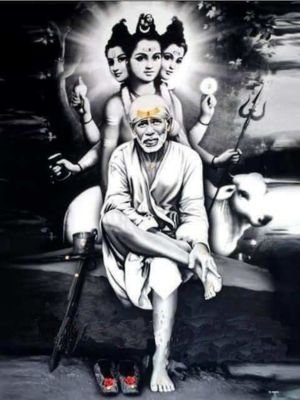Lord Dadaathreya

Tirumoorthi of Brahma
Dattatreya, or Sri Datta, as he is also referred to, is a Hindu deity who is also regarded as an aspect of the Divine Trinity or Tirumoorthi of Brahma, Vishnu and Maheshwara.The name “Dattatreya” is derived from two Sanskrit words, Datta (which means “given”) and Atreya (which refers to the sage Atri, who was also Datta’s biological father).
In the Nath tradition of Hinduism, Dattatreya is considered to be an avatar or reincarnation of Lord Shiva and is revered as the Adi-Guru or the First Teacher of the Adinath Sampradaya of the Nath sect of followers. Dattatreya first emerged as a teacher of Yoga, with clear Tantric traits. But later, he was accepted and absorbed into many other cults and sects, even including the more conventional Vaishnavism. He is also considered more of a God today, than a teacher. Today, this deity is worshiped by a multitude of Hindus from all walks of life, spanning the entire globe.
Dattatreya is regarded as one of the most ancient deities. The earliest references to him can be found as far back as in the Ramayana and the Mahabharata. The Dattatreya Upanishad, which is part of the Atharva Veda, describes him as variously taking the form of a child, a madman and even a demon, in order to help his followers attain moksha (liberation) from the material world.
In the earliest Tantric traditions, this deity was portrayed with only one head. Gorakshanath was responsible for including Sri Datta in the Nath Sampradaya and giving the deity a socially acceptable form today. The current three-headed form of Guru Sri Datta was probably introduced in the last 900 years or so.Data is believed to be the author of the Tripura Rahasya, a treatise on Advaita Vedanta, which was given to Parashurama.
Lord Dattatreya Story & Dattatreya’s Birth
Data Was Born To Sage Atri, Who Had Been Granted A Boon By Lord Shiva That He Would Be Born In Their Household, To The Sage Himself. Lord Shiva Or Parameshwara, Being Part Of The Trinity, Dattatreya Automatically Becomes An Aspect Of The Trimurti.Yet Another Legend Of Datta’s Birth Suggests A Rather Mystical Origin Of This Deity. Some Sources Believe That He Was Born In The Jungles Of Kashmir, Very Close To The Holy Amarnath.
Lord Dattatreya’s Childhood
Young Datta Left His Home At A Very Tender Age, To Roam Naked In Search Of The Absolute One. He Wandered Around Gujarat, Maharashtra, North Karnataka And Andhra Pradesh. He Is Believed To Have Attained Enlightenment In A Town In Karnataka, Known As Ganagapura. It Is Also Said That His Original Footprints Can Still Be Seen In A Lonely Peak At Girnar.Even The Treatise Tripura Rahasya Refers To Parashurama Finding Dattatreya Meditating On A Peak On The Gandha Madana Mountain.
Dattatreya As An Avatar Of The Trinity
Three Of Dattatreya’s Closest Disciples Were Kings. While One Of Them Was An Asura, The Others Belonged To The Kshatriya (Warrior) Clan. Dattatreya Was At First Regarded As An Avatar Of Shiva. But Later, Vaishnavites Claimed That He Was An Avatar Of Vishnu. But Many Hindus Regard Both Shiva And Vishnu’s As Two Aspects Of The Absolute Brahman. Hence, He Went On To Identify With The Trinity Themselves.
Interestingly, The Dattatreya Upanishad First Introduces Him As Being One With Vishnu And Ends With The Mantra, “Om Namah Shivaya”, Thereby Also Identifying Him With Shiva. Towards The End Of The Third Chapter, It Says That Shiva Pervades All Reality And Resides As The Eternal Jyoti (Divine Light) In The Heart Of Every Man. Shiva Is Described Here As Being Omnipresent And Omniscient. Finally, The Chapter Closes With The Description Of Shiva As Of Being That Of Dattatreya. In The Dasham Granth, Guru Gobind Singh Describes Dattatreya (Datt Muni/Datt Dev) As Being The Incarnation Of Rudra, The Supreme Power. This Treatise Also Narrates The Entire Life Story Of Datta.
Appearance Of Dattatreya
Shri Dattatreya Is Portrayed In Different Ways In Different Traditions Among The Hindus. However, The Most Commonly Portrayed Image As Having Six Hands; The Lowest Two Hands Holding A Mala (Garland) And A Kamandalu (Water Pot). The Middle Two Hands Are Shown Holding The Sacred Shankha (Conch) And Chakra (Discus). Occasionally, Portraits Also Show Him Holding The Gada (Mace). He Is Also Shown As Accompanied By 4 Dogs And A Cow.
Significance Of The Form Of Lord Dattatreya
Dattatreya Is Shown Having 3 Heads And A Form That Resonates Peace And Serenity. In The Present Kali Yuga, It Is Only Through Pure, Divine Love, That One Can Go Beyond Just Being Poised And Actually Attain That Type Of Calmness And Serenity. Only Those Extremely Dharmic (Righteous) Can Follow The Fourfold Path Of Yoga And Go Ahead To Discover The Absolute Truth. Guru Datta Radiates That Very Love And Compassion, Thereby Emanating That Peace And Love From His Person.